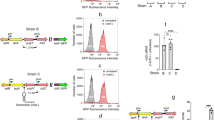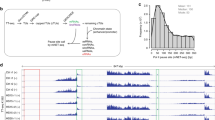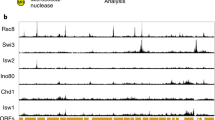Abstract
H-NS is a protein of the bacterial nucleoid involved in DNA compaction and transcription regulation. In vivo, H-NS selectively silences specific genes of the bacterial chromosome. However, many studies have concluded that H-NS binds sequence-independently to DNA, leaving the molecular basis for its selectivity unexplained. We show that the negative regulatory element (NRE) of the supercoiling-sensitive Escherichia coli proU gene contains two identical high-affinity binding sites for H-NS. Cooperative binding of H-NS is abrogated by changes in DNA superhelical density and temperature. We further demonstrate that the high-affinity sites nucleate cooperative binding and establish a nucleoprotein structure required for silencing. Mutations in these sites result in loss of repression by H-NS. In this model, silencing at proU, and by inference at other genes directly regulated by H-NS, is tightly controlled by the cooperativity between bound H-NS molecules.
This is a preview of subscription content, access via your institution
Access options
Subscribe to this journal
Receive 12 print issues and online access
$189.00 per year
only $15.75 per issue
Buy this article
- Purchase on Springer Link
- Instant access to full article PDF
Prices may be subject to local taxes which are calculated during checkout





Similar content being viewed by others
References
Atlung, T. & Ingmer, H. H-NS: a modulator of environmentally regulated gene expression. Mol. Microbiol. 24, 7–17 (1997).
Ono, S. et al. H-NS is a part of a thermally controlled mechanism for bacterial gene regulation. Biochem. J. 391, 203–213 (2005).
Hansen, A.M. et al. SspA is required for acid resistance in stationary phase by downregulation of H-NS in Escherichia coli. Mol. Microbiol. 56, 719–734 (2005).
Laaberki, M.H., Janabi, N., Oswald, E. & Repoila, F. Concert of regulators to switch on LEE expression in enterohemorrhagic Escherichia coli O157:H7: interplay between Ler, GrlA, H-NS and RpoS. Int. J. Med. Microbiol. 296, 197–210 (2006).
Stella, S., Falconi, M., Lammi, M., Gualerzi, C.O. & Pon, C.L. Environmental control of the in vivo oligomerization of nucleoid protein H-NS. J. Mol. Biol. 355, 169–174 (2006).
Goransson, M. et al. Transcriptional silencing and thermoregulation of gene expression in Escherichia coli. Nature 344, 682–685 (1990).
Schnetz, K. & Wang, J.C. Silencing of the Escherichia coli bgl promoter: effects of template supercoiling and cell extracts on promoter activity in vitro. Nucleic Acids Res. 24, 2422–2428 (1996).
Dame, R.T., Wyman, C. & Goosen, N. Structural basis for preferential binding of H-NS to curved DNA. Biochimie 83, 231–234 (2001).
Rimsky, S., Zuber, F., Buckle, M. & Buc, H. A molecular mechanism for the repression of transcription by the H-NS protein. Mol. Microbiol. 42, 1311–1323 (2001).
Spurio, R., Falconi, M., Brandi, A., Pon, C.L. & Gualerzi, C.O. The oligomeric structure of nucleoid protein H-NS is necessary for recognition of intrinsically curved DNA and for DNA bending. EMBO J. 16, 1795–1805 (1997).
Badaut, C. et al. The degree of oligomerization of the H-NS nucleoid structuring protein is related to specific binding to DNA. J. Biol. Chem. 277, 41657–41666 (2002).
Prosseda, G. et al. The virF promoter in Shigella: more than just a curved DNA stretch. Mol. Microbiol. 51, 523–537 (2004).
Pul, U. et al. LRP and H-NS - cooperative partners for transcription regulation at Escherichia coli rRNA promoters. Mol. Microbiol. 58, 864–876 (2005).
Shin, M. et al. DNA looping-mediated repression by histone-like protein H-NS: specific requirement of Esigma70 as a cofactor for looping. Genes Dev. 19, 2388–2398 (2005).
Spassky, A., Rimsky, S., Garreau, H. & Buc, H. H1a, an E. coli DNA-binding protein which accumulates in stationary phase, strongly compacts DNA in vitro. Nucleic Acids Res. 12, 5321–5340 (1984).
Ali Azam, T., Iwata, A., Nishimura, A., Ueda, S. & Ishihama, A. Growth phase-dependent variation in protein composition of the Escherichia coli nucleoid. J. Bacteriol. 181, 6361–6370 (1999).
Yamada, H., Yoshida, T., Tanaka, K., Sasakawa, C. & Mizuno, T. Molecular analysis of the Escherichia coli hns gene encoding a DNA-binding protein, which preferentially recognizes curved DNA sequences. Mol. Gen. Genet. 230, 332–336 (1991).
Owen-Hughes, T.A. et al. The chromatin-associated protein H-NS interacts with curved DNA to influence DNA topology and gene expression. Cell 71, 255–265 (1992).
Rimsky, S. & Spassky, A. Sequence determinants for H1 binding on Escherichia coli lac and gal promoters. Biochemistry 29, 3765–3771 (1990).
Lucht, J.M., Dersch, P., Kempf, B. & Bremer, E. Interactions of the nucleoid-associated DNA-binding protein H-NS with the regulatory region of the osmotically controlled proU operon of Escherichia coli. J. Biol. Chem. 269, 6578 (1994).
Gowrishankar, J. & Manna, D. How is osmotic regulation of transcription of the Escherichia coli proU operon achieved: a review and a model. Genetica 97, 363–378 (1996).
Csonka, L.N. Physiological and genetic responses of bacteria to osmotic stress. Microbiol. Rev. 53, 121–147 (1989).
Rajkumari, K., Kusano, S., Ishihama, A., Mizuno, T. & Gowrishankar, J. Effects of H-NS and potassium glutamate on σS- and σ70-directed transcription in vitro from osmotically regulated P1 and P2 promoters of proU in Escherichia coli. J. Bacteriol. 178, 4176–4181 (1996).
Rajkumari, K. & Gowrishankar, J. In vivo expression from the RpoS-dependent P1 promoter of the osmotically regulated proU operon in Escherichia coli and Salmonella enterica serovar Typhimurium: activation by rho and hns mutations and by cold stress. J. Bacteriol. 183, 6543–6550 (2001).
Tanaka, K., Ueguchi, C. & Mizuno, T. Importance of stereospecific positioning of the upstream cis-acting DNA element containing a curved DNA structure for the functioning of the Escherichia coli proV promoter. Biosci. Biotechnol. Biochem. 58, 1097–1101 (1994).
Csonka, L.N., Ikeda, T.P., Fletcher, S.A. & Kustu, S. The accumulation of glutamate is necessary for optimal growth of Salmonella typhimurium in media of high osmolality but not induction of the proU operon. J. Bacteriol. 176, 6324–6333 (1994).
Jordi, B.J. & Higgins, C.F. The downstream regulatory element of the proU operon of Salmonella typhimurium inhibits open complex formation by RNA polymerase at a distance. J. Biol. Chem. 275, 12123–12128 (2000).
Dattananda, C.S., Rajkumari, K. & Gowrishankar, J. Multiple mechanisms contribute to osmotic inducibility of proU operon expression in Escherichia coli: demonstration of two osmoresponsive promoters and of a negative regulatory element within the first structural gene. J. Bacteriol. 173, 7481–7490 (1991).
Overdier, D.G. & Csonka, L.N. A transcriptional silencer downstream of the promoter in the osmotically controlled proU operon of Salmonella typhimurium. Proc. Natl. Acad. Sci. USA 89, 3140–3144 (1992).
Fletcher, S.A. & Csonka, L.N. Fine-structure deletion analysis of the transcriptional silencer of the proU operon of Salmonella typhimurium. J. Bacteriol. 177, 4508–4513 (1995).
Navarre, W.W. et al. Selective silencing of foreign DNA with low GC content by the H-NS protein in Salmonella. Science 313, 236–238 (2006).
Lucchini, S. et al. H-NS mediates the silencing of laterally acquired genes in bacteria. PLoS Pathog. 2, e81 (2006).
Grainger, D.C., Hurd, D., Goldberg, M.D. & Busby, S.J. Association of nucleoid proteins with coding and non-coding segments of the Escherichia coli genome. Nucleic Acids Res. 34, 4642–4652 (2006).
Dame, R.T., Noom, M.C. & Wuite, G.J. Bacterial chromatin organization by H-NS protein unravelled using dual DNA manipulation. Nature 444, 387–390 (2006).
Leonard, A.C. & Grimwade, J.E. Building a bacterial orisome: emergence of new regulatory features for replication origin unwinding. Mol. Microbiol. 55, 978–985 (2005).
Zawilak-Pawlik, A. et al. Architecture of bacterial replication initiation complexes: orisomes from four unrelated bacteria. Biochem. J. 389, 471–481 (2005).
Hulton, C.S. et al. Histone-like protein H1 (H-NS), DNA supercoiling, and gene expression in bacteria. Cell 63, 631–642 (1990).
Oshima, T., Ishikawa, S., Kurokawa, K., Aiba, H. & Ogasawara, N. Escherichia coli histone-like protein H-NS preferentially binds to horizontally acquired DNA in association with RNA polymerase. DNA Res. 13, 141–153 (2006).
Blot, N., Mavathur, R., Geertz, M., Travers, A. & Muskhelishvili, G. Homeostatic regulation of supercoiling sensitivity coordinates transcription of the bacterial genome. EMBO Rep. 7, 710–715 (2006).
Jubelin, G. et al. CpxR/OmpR interplay regulates curli gene expression in response to osmolarity in Escherichia coli. J. Bacteriol. 187, 2038–2049 (2005).
Sardesai, A.A. & Gowrishankar, J. Improvement in K+-limited growth rate associated with expression of the N-terminal fragment of one subunit (KdpA) of the multisubunit Kdp transporter in Escherichia coli. J. Bacteriol. 183, 3515–3520 (2001).
Browning, D.F., Cole, J.A. & Busby, S.J. Suppression of FNR-dependent transcription activation at the Escherichia coli nir promoter by Fis, IHF and H-NS: modulation of transcription initiation by a complex nucleo-protein assembly. Mol. Microbiol. 37, 1258–1269 (2000).
Dame, R.T. et al. DNA bridging: a property shared among H-NS-like proteins. J. Bacteriol. 187, 1845–1848 (2005).
Muskhelishvili, G., Buckle, M., Heumann, H., Kahmann, R. & Travers, A.A. FIS activates sequential steps during transcription initiation at a stable RNA promoter. EMBO J. 16, 3655–3665 (1997).
Stella, S., Spurio, R., Falconi, M., Pon, C.L. & Gualerzi, C.O. Nature and mechanism of the in vivo oligomerization of nucleoid protein H-NS. EMBO J. 24, 2896–2905 (2005).
Dame, R.T. The role of nucleoid-associated proteins in the organization and compaction of bacterial chromatin. Mol. Microbiol. 56, 858–870 (2005).
Schneider, R. et al. An architectural role of the Escherichia coli chromatin protein FIS in organising DNA. Nucleic Acids Res. 29, 5107–5114 (2001).
Higgins, C.F. et al. A physiological role for DNA supercoiling in the osmotic regulation of gene expression in S. typhimurium and E. coli. Cell 52, 569–584 (1988).
Hardy, C.D. & Cozzarelli, N.R. A genetic selection for supercoiling mutants of Escherichia coli reveals proteins implicated in chromosome structure. Mol. Microbiol. 57, 1636–1652 (2005).
Tanaka, K., Muramatsu, S., Yamada, H. & Mizuno, T. Systematic characterization of curved DNA segments randomly cloned from Escherichia coli and their functional significance. Mol. Gen. Genet. 226, 367–376 (1991).
Ho, S.N., Hunt, H.D., Horton, R.M., Pullen, J.K. & Pease, L.R. Site-directed mutagenesis by overlap extension using the polymerase chain reaction. Gene 77, 51–59 (1989).
Williams, R.M., Rimsky, S. & Buc, H. Probing the structure, function, and interactions of the Escherichia coli H-NS and StpA proteins by using dominant negative derivatives. J. Bacteriol. 178, 4335–4343 (1996).
Brenowitz, M., Senear, D.F., Shea, M.A. & Ackers, G.K. Quantitative DNase footprint titration: a method for studying protein-DNA interactions. Methods Enzymol. 130, 132–181 (1986).
Krueger, A., Protozanova, E. & Frank-Kamenetskii, M.D. Sequence-dependent basepair opening in DNA double helix. Biophys. J. 90, 3091–3099 (2006).
Acknowledgements
This work was supported by the Centre National de la Recherche Scientifique and the Agence Nationale pour la Recherche (projet MASTRIT). E.B. was funded by the Fondation pour La Recherche Médicale and the Ministère délégué à l'Enseignement supérieur et à la Recherche. We thank B. Robert and J. Gowrishankar for comments on the manuscript, I. Pemberton for his advice with the various constructions, G. Mitchison (University of Cambridge) for writing the DNA stability plot program and P. Bertin for kindly providing the strains.
Author information
Authors and Affiliations
Corresponding author
Ethics declarations
Competing interests
The authors declare no competing financial interests.
Supplementary information
Supplementary Fig. 1
Footprinting on a modified proU sequence at positions +130 and +25. (PDF 174 kb)
Rights and permissions
About this article
Cite this article
Bouffartigues, E., Buckle, M., Badaut, C. et al. H-NS cooperative binding to high-affinity sites in a regulatory element results in transcriptional silencing. Nat Struct Mol Biol 14, 441–448 (2007). https://doi.org/10.1038/nsmb1233
Received:
Accepted:
Published:
Issue Date:
DOI: https://doi.org/10.1038/nsmb1233
This article is cited by
-
Transcription-driven DNA supercoiling counteracts H-NS-mediated gene silencing in bacterial chromatin
Nature Communications (2024)
-
The environmentally-regulated interplay between local three-dimensional chromatin organisation and transcription of proVWX in E. coli
Nature Communications (2023)
-
Overexpression of the third H-NS paralogue H-NS2 compensates fitness loss in hns mutants of the enteroaggregative Escherichia coli strain 042
Scientific Reports (2020)
-
Comparative analysis of Aliivibrio logei luxR1 and luxR2 genes regulation in Escherichia coli cells
Archives of Microbiology (2019)
-
Horizontally acquired AT-rich genes in Escherichia coli cause toxicity by sequestering RNA polymerase
Nature Microbiology (2017)



